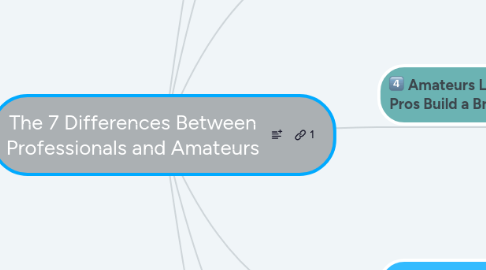The 7 Differences Between Professionals and Amateurs
by Danny Forest


1. Amateurs Wait for Clarity. Pros Take Action.
1.1. Self-awareness is an important part of life, and it’s especially important for creatives. But there’s a right way and a wrong way to go about this.
1.2. Clarity comes with action
1.3. Your confidence comes from knowing what you are and your commitment to acting on that knowledge.
2. Amateurs Want to Arrive. Pros Want to Get Better.
2.1. You have to become a student long before you get to be a master.
2.2. It wasn’t until I started putting myself around teachers and around the teaching of true masters that I realized how little I knew and how much I still had to grow as a writer.
2.2.1. Hemingway did this, too — it wasn’t until he spent a few years at the feet of Gertrude Stein and Sherwood Anderson in Paris that he grew from a good writer into a masterful one.
2.3. If you don’t do this, you delude yourself into thinking you’re better than you really are, which is the fastest route to failure and anonymity.
3. Amateurs Practice as Much as They Have To. Pros Never Stop.
3.1. You have to practice even, maybe especially, when it hurts.
3.2. You have to keep challenging yourself, keep pushing yourself beyond your limits. This is how we grow.
3.3. Frequency trumps quantity. It’s better to work a little toward mastering your craft every day than a lot once in a while.
4. Amateurs Leap for Their Dreams. Pros Build a Bridge.
4.1. It’s not about the giant leaps of faith or big breaks that will make your career. It’s the daily practice.
4.2. You have to put the time in, but it’s more of a marathon than a sprint.
4.2.1. I took a leap every time I started a new blog. I did this eight times, every time I had a new idea. But none of those blogs stuck until I decided to stick with one, which is the blog I write on today.
4.3. What’s the thing that really needs to “stick?” It’s not the idea. It’s the person.
5. Amateurs Fear Failure. Pros Crave It.
5.1. You have to fail your way to success.
5.2. Failure is feedback, and truly successful people use it to move forward in their careers.
5.3. Failure is the only way you get to success and each of my failures has taught me something I wouldn’t have been able to move forward without.
5.3.1. Thomas Edison, in his efforts to invent a working light bulb, once said, “I have not failed. I have just found 10,000 ways that won’t work.” How many times are you willing to get it wrong?
